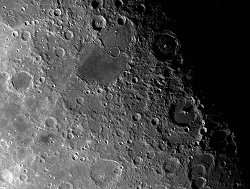The Sky is Falling

Up on the Moon, the sky is falling. "Every day, more than a metric ton of meteoroids hits the Moon," says Bill Cooke of the Marshall Space Flight Center's Meteoroid Environment Office. They literally fall out of the sky, in all shapes and sizes, from specks of comet dust to full-blown asteroids, traveling up to a hundred thousand mph. And when they hit, they do not disintegrate harmlessly in the atmosphere as most would on Earth. On the airless Moon, meteoroids hit the ground.
Apollo astronauts were never bothered by these projectiles. The Moon has a surface area roughly equal to the continent of Africa. "If you spread the impacts over so much terrain, the probability of being hit is very low," says Cooke. It helped that the astronauts didn't stay long: Adding all Apollo missions together, they were on the lunar surface less than two weeks. "The odds of being hit during such a short time were, again, very low."
But what about next time? Following the Vision for Space Exploration, NASA is sending astronauts back to the Moon to stay longer and build bigger bases (read: bigger targets) than Apollo astronauts ever did. The odds of something precious being hit will go up. Should NASA be worried?
That's what Cooke and MSFC colleague Anne Diekmann are trying to find out.
The truth is, "we really don't know how many meteoroids hit the Moon every day," he says. "Our best estimates come from the 'Standard Meteoroid Model,' which NASA uses to evaluate hazards to the space station and the space shuttle." Problem: The Standard Model is based mainly on Earth-data, e.g., satellite observations of meteoroids hitting Earth’s upper atmosphere and human observations of meteors flitting across the night sky. "The Standard Model may not work well for the Moon."
For lunar purposes, "we need more data," says Cooke. Fortunately, there are more data. It comes from Apollo:
Clues to how often and how hard the Moon is hit lie in data from four seismometers placed on the Moon by the Apollo 12, 14, 15, and 16 missions during 1969-72. They operated until NASA turned them off in 1977. For years, the seismometers recorded all manner of tremors and jolts, including almost 3000 moonquakes, 1700 meteoroid strikes, and 9 spacecraft deliberately crashed into the Moon. All these data were transmitted to Earth for analysis.
"Here's what's interesting," says Cooke. "Of some 12,000 events recorded by the seismometers, less than half have been explained by known phenomena. There are thousands of tremors caused by ... no one knows what."
He has a hunch: "Many of them may be meteoroid impacts."
"Apollo scientists were very bright," says Cooke, "but they didn't have the benefit of modern computers. We do." Cooke and Diekmann are now loading the old seismic data into machines at the MSFC where they can perform digital calculations at speeds impossible 30 years ago, rapidly trying new algorithms to find previously unrecognized impacts.
Critical to the analysis are nine man-made impacts. "NASA deliberately crashed some spacecraft into the Moon while the seismometers were operating," he explains. "They were the empty ascent stages of four lunar modules (Apollo 12, 14, 15 and 17) and the SIV-B stages of five Saturn rockets (Apollo 13, 14, 15, 16 and 17)." Their seismic waveforms tell researchers what an impact should look like.
Also, in 1972, a 1,100 kg (2,400 lb) asteroid hit the Moon just north of Mare Nubium, the Sea of Clouds. It was a major impact recorded at all four seismic stations. "When we look at the seismic waveform of that asteroid," says Cooke, "we see that it has the same characteristics as the man-made impacts—a good sign that we know what we’re doing."

Cooke and Diekmann will hunt for impacts in the Apollo seismic records using these known waveforms as a reference. In theory, they should be able to pick out tremors from objects as small as 10 centimeters (4 inches), weighing as little as 1 kg (2.2 lb). "Four inches doesn't sound like much, but traveling at cosmic velocities, a four-inch meteoroid can blast a crater as wide as your desk."
According to the Standard Model, such meteoroids hit the Moon approximately 400 times a year—more than once a day. (Picture a map of Africa stuck with 400 pushpins.) The Apollo seismic dataset can test that prediction and many others.
The analysis is just beginning. "We hope to find many impacts," he says. Regardless of the final numbers, however, their work will have value. "We're developing new algorithms to find meteoroid impacts in seismic data." Eventually, Cooke believes, next-generation seismometers will be placed on the Moon and Mars to monitor quakes and impacts, and when the data start pouring in, "we'll be ready."
Source: Science@NASA, by Dr. Tony Phillips and Dave Dooling





















